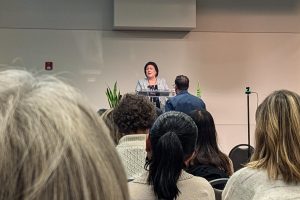Struggling between passion and finance
Student leadership compensation falls short, no money for pay bump
February 26, 2020

Each officer of ASSP core is paid $8,500. With six officers, the total compensation is $51,000.
Compensation for the work of student leaders is not a new issue.
According to the ASSP Constitution, student fees fund ASSP, other groups under the Office of Student Involvement and Leadership (OSIL), such as Outdoor Recreational Program (ORP) and Student Union Board (STUB) and the other student leadership groups overseen by ASSP.
Student leaders do not have time to pursue other methods of making money. While their positions as leaders are valuable, sometimes that experience is not enough.
“Like it’s enough for me to pay for my food, but not for books,” said Cascade Editor-in-Chief Audrey Easley. “It’s hard because I want to get another job, but it’s just very consuming.”
Currently, there is a struggle to find a balance between students pursuing their passions through leadership but also finding financial stability within that. Many students are unable to pursue the roles of leadership because of this.
Bear in mind, the information presented here is a sliver of how Seattle Pacific University handles student leadership pay. While student fees funds all of the student leadership positions, according to the ASSP constitution less than 44% of student fees are used for student leadership compensation.
According to the Director of OSIL, Whitney Broteje, student leadership compensation is recommended by the Allocation Board and approved ASSP. Those student leadership positions are all ASSP core positions, ASSP Club Coordinator, ASSP IT Coordinator & Webmaster, ASSP Publicist, Catalyst coordinator positions and student media positions (Cascade, KSPU, Lingua and The Falcon).
The pay of the ASSP core members seems to be historically larger than other leaders that are both under ASSP and OSIL.
For example, there are six positions within ASSP core and each core member is paid $8,500 a year, a total of $51,000. Between the four media groups on campus, the compensation for non-coordinator media positions — meaning Editor-in-Chief or Station Manager — is split between Cascade, KSPU, Lingua and The Falcon is $90,956.
That said, there are many other factors that determine compensation for student leadership. But for many current student leaders, there is a tension between the desire to lead in a role they are passionate about, and the necessity of taking on an additional job in order to meet their financial needs.
“I don’t want to ever be put in a space where students feel like they are being used or taken advantage of because of their time in leadership,” said Brotege.
Cascade, which creates SPU’s year book, has seven paid positions, including the editor-in-chief, two editors, two photographers, a business manager and a copy editor. Easley said she is paid just under $5,000 for the year.
She is constantly sending emails, works with scheduling and checks in with her team to make sure things are getting done on time. The amount of hours she works varies from week to week.
“My hours definitely change based on what we are doing, so there will be times where I’m working 20 to 30 hours a week. And then times where I just work a few hours,” Easley said.
The position is important to Easley, but also can cause financial stress at times due the time that she puts into Cascade does not feel equivalent to her pay.
Easley emphasized how grateful she is for her position with Cascade because she believes it offers great resume experience, but wishes it would be enough to help her be financially sufficient.
“It’s hard because I appreciate this position so much and I am learning so much,” Easley said. “But I will say as a senior design student — and I am taking twenty credits, and on top of all of that with Cascade — I can’t get another job. So the amount I am getting paid is not enough for me, personally.”
Like Cascade, KSPU is another group that is overseen by ASSP. Micahel Miller, the station manager, said his pay is around $5,000.
Miller’s main responsibilities are helping with coordinating events, checking in with the other staff members, answering emails and budget management.
Miller said that his hours vary week from week, depending on how busy the station is.
“I would say that my pay is pretty equivalent to the hours I work,” Miller said.
“I have this job, I work at the library on campus and I write for a bunch of other websites, so it’s nice when I get paid for that,” Miller said in response to whether he needed a job outside of KSPU.
Lhakpa Sherpa, the coordinator of ORP, shares similar sentiments as the other two student leaders.
Sherpa works around twelve hours a week, helping coordinate events, answering emails and helping with social media posts and gets paid $5,049 for the year.
Sherpa loves working for ORP, but, like many other student leaders on campus, he had to get another job outside of ORP because of how little he gets paid for his position.
“Based on the time that I put in, I don’t get enough for what I do. But I really enjoy it, so I try to think of it like ‘wow, I’m getting paid for something I really love to do,’” Sherpa said.
According to Broteje, ASSP is overseen by OSIL, along with groups like STUB and ORP. But whether or not student leaders’ compensation is handled by ASSP or OSIL, there is a tension between getting involved at SPU and receiving completely equitable compensation.
“In an ideal world, I would love to pay people equitably for their time,” Broteje said.
For students like Easley, Miller and Sherpa, it can be hard to reconcile wanting to make more money and still wanting to do something they are passionate about.
“Of course, everybody would say they wish that their position is paid more,” Easley said.
“There are definitely times where I wish that I got paid more, but I also try to think about the fact that I am getting experience. It’s a very valuable experience but it makes financial experiences harder.”


























































































